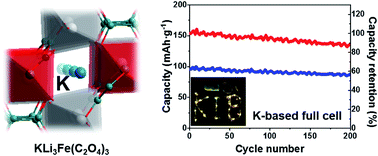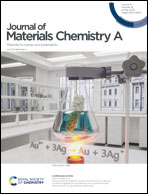An iron-based polyanionic cathode for potassium storage with high capacity and excellent cycling stability†
Abstract
Potassium storage systems are attracting more and more attention for large scale energy storage owing to the great abundance of potassium in the earth. The development of potassium-based devices has so far been hindered by the lack of appropriate potassium-host materials since the large radius of potassium has put forward the requirement of more rigid frameworks and larger channels for K ion migration, in comparison with lithium and sodium-based devices. In this study, we report an iron-based oxalate as a positive electrode for K-ion storage. KLi3Fe(C2O4)3@C delivered a stable capacity of 140 mA h g−1 at 120 mA g−1, and showed a 91% capacity retention after 200 cycles. By combining cyclic voltammetry analysis and synchrotron X-ray absorption spectroscopy, the K storage mechanism is demonstrated to be a combined Fe2+/Fe3+ redox reaction and pseudocapacitive process. Remarkably, it displays a stable capacity of ∼130 mA h g−1 and little attenuation over 5000 cycles at 240 mA g−1 in the lifespan test. A K-based full cell was successfully constructed via pairing this cathode with a soft carbon anode and exhibited good rate capability together with a capacity retention of ∼90% for 200 cycles, indicating its promising prospect as an environment friendly and stable K-storage cathode.



 Please wait while we load your content...
Please wait while we load your content...